Vase with iris
Art Nouveau ceramics, produced from around 1880 to 1914, the start of World War I, encompassed a variety of different styles and influences, including national historicism, nature, symbolism, and an interest in Japanese culture. The period’s diverse practitioners were driven by the search for new forms that responded to the sweeping social, cultural, economic and artistic changes wrought by industrialization at the end of the nineteenth century and the advent of World War I. Trained as a sculptor and painter, d’Eaubonne worked at the Sèvres manufactory in the first decades of the twentieth century. This dynamically modeled vase with an Iris is unlike his typical work at the porcelain manufactory, where he specialized in highly controlled, classically inspired frieze-like decorations.
Artwork Details
- Title: Vase with iris
- Designer: Lucien Jules Clément d'Eaubonne (French, b. 1870)
- Manufactory: Sèvres Manufactory (French, 1740–present)
- Date: ca. 1903–04
- Culture: French, Sèvres
- Medium: Glazed stoneware
- Dimensions: confirmed: 14 11/16 × 5 3/4 × 5 3/4 in. (37.3 × 14.6 × 14.6 cm)
- Classification: Ceramics-Pottery
- Credit Line: Gift of Martin Eidelberg, 2024
- Object Number: 2024.450.7
- Curatorial Department: European Sculpture and Decorative Arts
More Artwork
Research Resources
The Met provides unparalleled resources for research and welcomes an international community of students and scholars. The Met's Open Access API is where creators and researchers can connect to the The Met collection. Open Access data and public domain images are available for unrestricted commercial and noncommercial use without permission or fee.
To request images under copyright and other restrictions, please use this Image Request form.
Feedback
We continue to research and examine historical and cultural context for objects in The Met collection. If you have comments or questions about this object record, please contact us using the form below. The Museum looks forward to receiving your comments.
